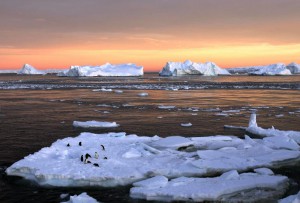Arctic sea ice shrinks to record low
By Tim Radford
LONDON, 30 March, 2016 – Researchers in the US say that Arctic sea ice has reached a record low winter maximum for the second year running.
Data from the US National Snow and Ice Data Center (NSIDC) and the US space agency NASA shows that the sea ice peaked on 24 March at 5.607 million square miles, or 14.52 million square kilometers. This is the lowest maximum since satellite measurements began in 1979.
“I’ve never seen such a warm, crazy winter in the Arctic,” says the NSIDC director, Mark Serreze. “The heat was relentless.”
The extent of the ice is only slightly smaller than the 2015 measurement of 5.612 million square miles, or 14.54 million square kilometres. The 13 smallest maximum extents of ice have all been recorded in the last 13 years.
Warmest year
The steady shrinking of the winter ice in the last four decades means that the Arctic has lost ice over 1.6 million square kilometers or 620,000 square miles – an area as big as the Xinjiang region in China, or twice the size of Texas.
The finding is no great s urprise: 2015 was the warmest year ever recorded, and both around the planet and in the Arctic, December, January and February all broke monthly temperature records. Air temperatures over the Arctic Ocean for those three months o
urprise: 2015 was the warmest year ever recorded, and both around the planet and in the Arctic, December, January and February all broke monthly temperature records. Air temperatures over the Arctic Ocean for those three months o
f were 2° to 6° C above average in nearly every region.
And not only were air temperatures at the edge of the ice significantly warmer than usual in the last century, warm winds from the south prevented the growth of the ice pack, and warming ocean waters continued to contain the sea ice extent.
The Arctic ice cap plays a powerful role in maintaining polar temperatures. Ice and snow reflect 60% of incoming solar radiation back into space, while blue seas absorb sunlight and accelerate warming.
So as the ice caps get smaller, they are likely to go on getting smaller. But what climate scientists call the albedo effect matters most in summer, when the sun is higher in the Arctic sky.
Summer melting
Ironically, the latest measurements come only months after researchers expressed hopes that, for the moment, the steady shrinking of the ice caps may have faltered.
The dwindling extent of winter ice also suggests that the summer melting could continue over time to be more extensive. The year 2012 saw the summer pack ice shrink to its lowest ever, and researchers now confidently expect the Arctic Ocean to become increasingly open to shipping for at least part of the year.
“It is likely that we’re going to keep seeing smaller wintertime maximums in the future because, in addition to a warmer atmosphere, the ocean has also warmed up,” says Walt Meier, a sea ice scientist at NASA’s Goddard Space Flight Centre in Maryland. “That warmer ocean will not let the ice edge expand as far south as it used to.”
“Although the maximum reach of the sea ice can vary a lot each year, depending on winter weather conditions, we’re seeing a significant downward trend, and that’s ultimately related to the warming atmosphere and oceans.” – Climate News Network







